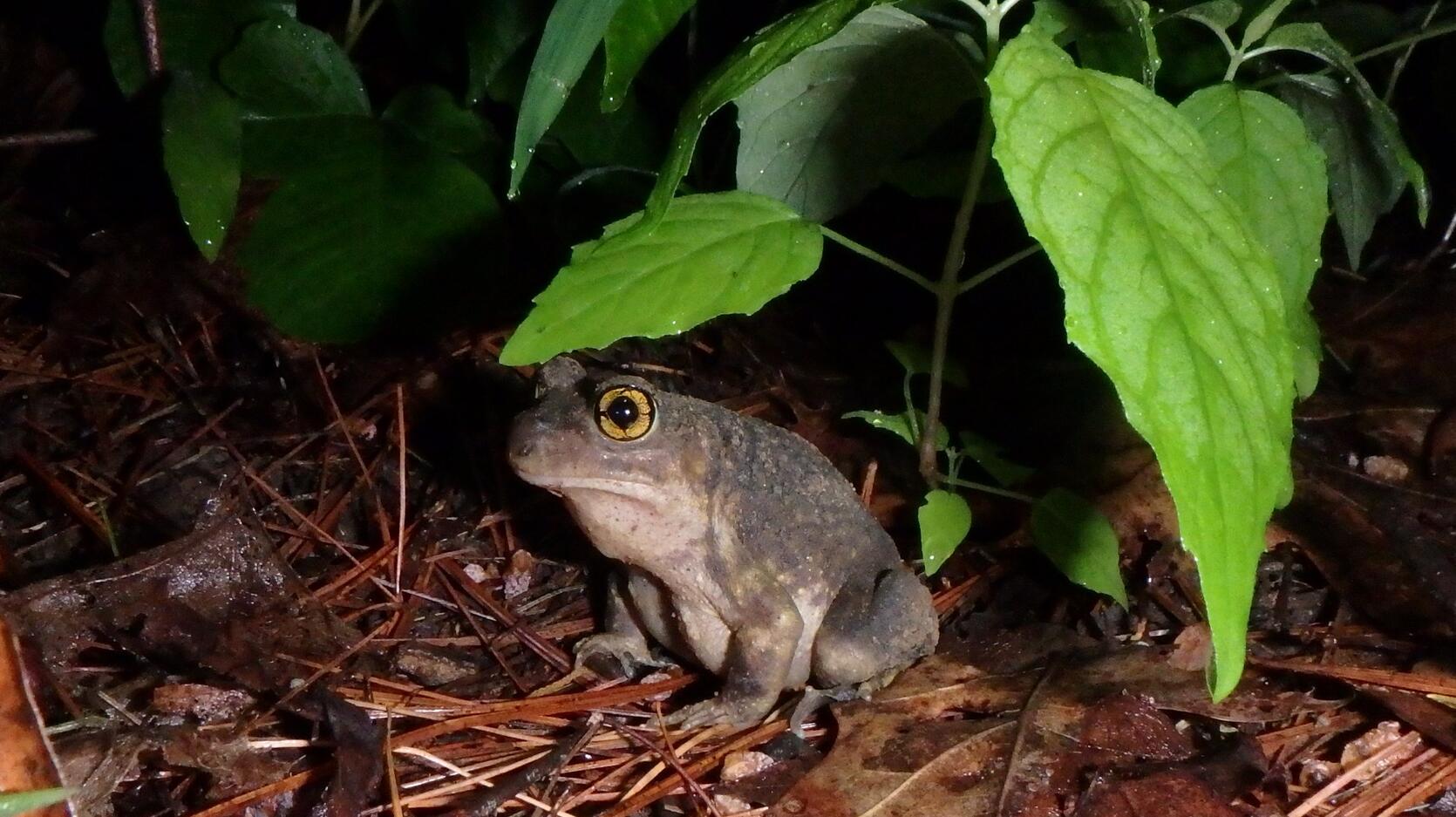- Division of Fisheries and Wildlife
- MassWildlife's Natural Heritage & Endangered Species Program

Eastern spadefoot (Scaphiopus holbrookii)—a fascinating, toad-like animal that spends most of its life underground—was once found widely across southern New England. Although Cape Cod still seems to be a stronghold, this regionally imperiled species has disappeared from all but a handful of locations among inland areas of Massachusetts, Connecticut, and Rhode Island. In general, coastal populations are relatively robust, but a rising sea level and other threats associated with climate change are placing added importance on managing inland populations for long-term conservation of the species in our region. MassWildlife's Natural Heritage and Endangered Species Program (NHESP) has been at the forefront of this effort, teaming with a variety of stakeholders to learn more about these populations and to identify and implement needed management actions.
Inland populations of eastern spadefoot are challenged, in part, by the species’ very specific habitat requirements. First, since they are burrowing animals, spadefoots need loose, sandy, or loamy soils that generally lack stone. Second, to breed and deposit their eggs, spadefoots rely on shallow basins that have a lot of sun exposure, fill with water as a result of surface flooding during exceptionally heavy or prolonged rains, and dry out in a matter of weeks following inundation. These conditions don’t occur in tandem in many places, and a number of sites that once supplied suitable habitat have been lost to development. An additional challenge to spadefoot conservation is that they do not reproduce every year. For example, most Massachusetts populations did not breed from 2014 to 2016 due to droughty spring weather. Warm seasons with high water tables are key for spadefoot breeding in New England, but such conditions are not guaranteed each year.
How you can help
- Report sightings of eastern spadefoot to MassWildlife! This threatened species occurs in regions with a lot of sandy/loamy soils with few stones; please refer to the eastern spadefoot fact sheet for distribution information. October is the last month of the species’ active season before it burrows deep underground for the winter. During this month, spadefoots emerge from the ground on warm, humid (or rainy) nights to feed. Their eyes have reflective lenses that glow a dull-red color when illuminated with a dim flashlight or headlamp, so they can be spotted from a distance in the dark. In residential settings, they typically sit beneath shrubs in mulched garden areas, but they are also seen on lawns, driveways, or other open areas. If you are out walking your dog at night or simply going to retrieve the mail, take a light with you and look for red eyes around mailbox posts, fence lines, and mulched areas!
- Donate to MassWildlife’s Natural Heritage and Endangered Species Program. NHESP conducts a variety of conservation projects for the benefit of rare species, but your financial support is critical to that effort!
Partnerships benefiting inland populations
In 2016, NHESP convened a diverse group of individuals interested in spadefoot conservation to develop a statewide monitoring initiative with emphasis on inland populations. The primary objective was to determine current statuses of the populations, as many had not been documented in 15–20 years. As this trusted group of amateur herpetologists, environmental professionals, citizen scientists, and academic faculty collected information, the initiative expanded to identify and develop some tangible conservation goals at select sites. Teaming with residents, municipalities, land trusts, and conservation organizations, NHESP has been coordinating efforts to meet those goals.
For example, NHESP worked recently with a Rehoboth resident and the Rehoboth Land Trust (RLT) to transfer ownership of the sole known breeding pool for a local spadefoot population to the RLT to ensure its permanent protection. The next goal for the site is to restore the pool basin to a more suitable condition, as it has become heavily shaded by tree growth over the years, and a portion was once filled for lawn expansion by a prior owner. Consequently, tadpole growth has been extremely slow (shading has prevented adequate warming of the water), and the basin has much less capacity than it did historically (contributing to premature drying). Captive-rearing of tadpoles by a member of the monitoring team has been necessary to ensure successful reproduction in each of the past 3 years.
In Wayland, MassWildlife worked with multiple residents, the town’s Conservation Department, and Zoo New England’s Grassroots Wildlife Conservation program to restore a breeding pool for the only relict population of eastern spadefoot still known from Middlesex County. The basin was cleared of a nearly impenetrable jungle of non-native, invasive shrubs and vines, thereby restoring open conditions to allow for rapid tadpole growth. NHESP has since worked closely with residents to monitor the basin and successful spadefoot reproduction has been confirmed there in each of the past 2 years.
In Sunderland, Hadley, and Amherst, where spadefoots have been observed on roadways over a wide geographic area, breeding habitat on protected land appears to be a limiting resource. MassWildlife has worked with the Kestrel Land Trust, a local landowner, and a group of dedicated volunteers to construct a vernal pool in hope that it will provide a steady boost to spadefoot reproduction in the area. NHESP is also working with residents and the Amherst Conservation Department to survey understudied pools that have potential to support spadefoots.
Survey work continued under the initial monitoring program is also feeding valuable information into experimental population introduction projects conducted by MassWildlife and MassAudubon. Further, the program has led to increased communication and sharing of information with the bordering states of Connecticut and Rhode Island. Through these various partnerships, MassWildlife and others are finding cost-effective ways to advance the conservation of eastern spadefoot in New England.

